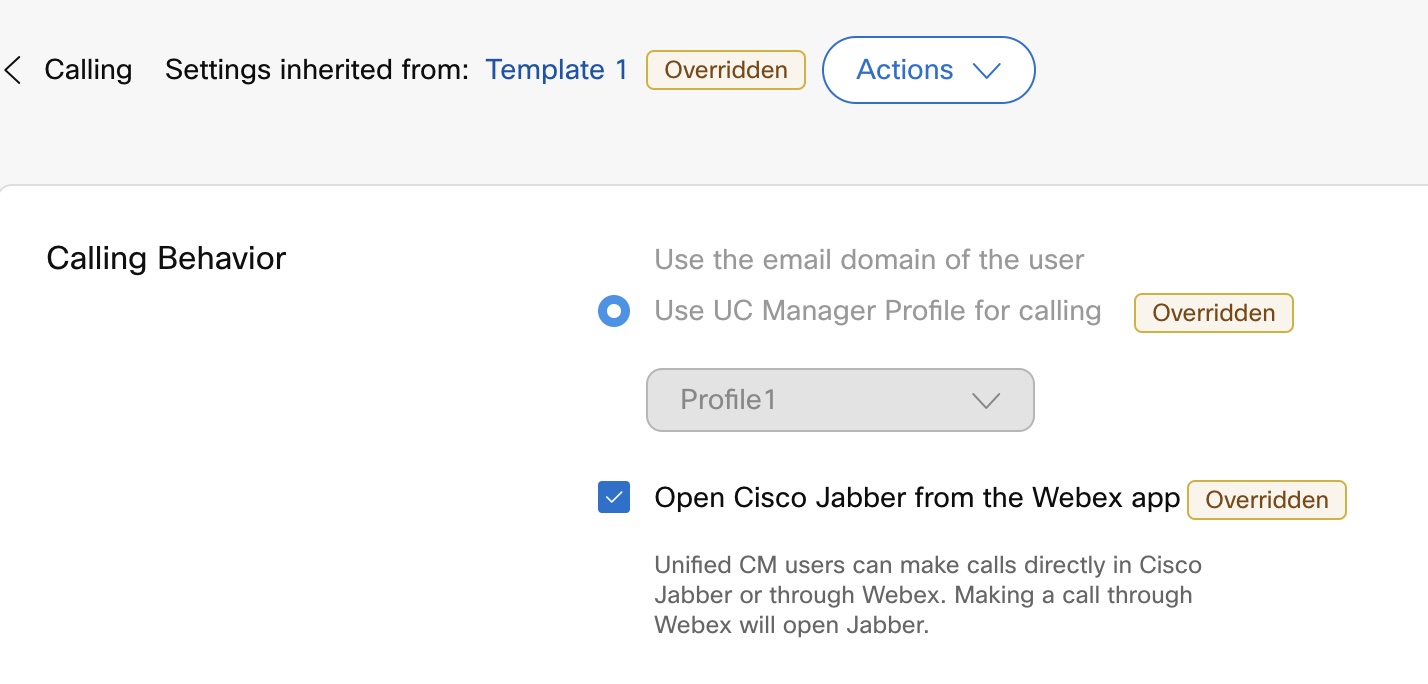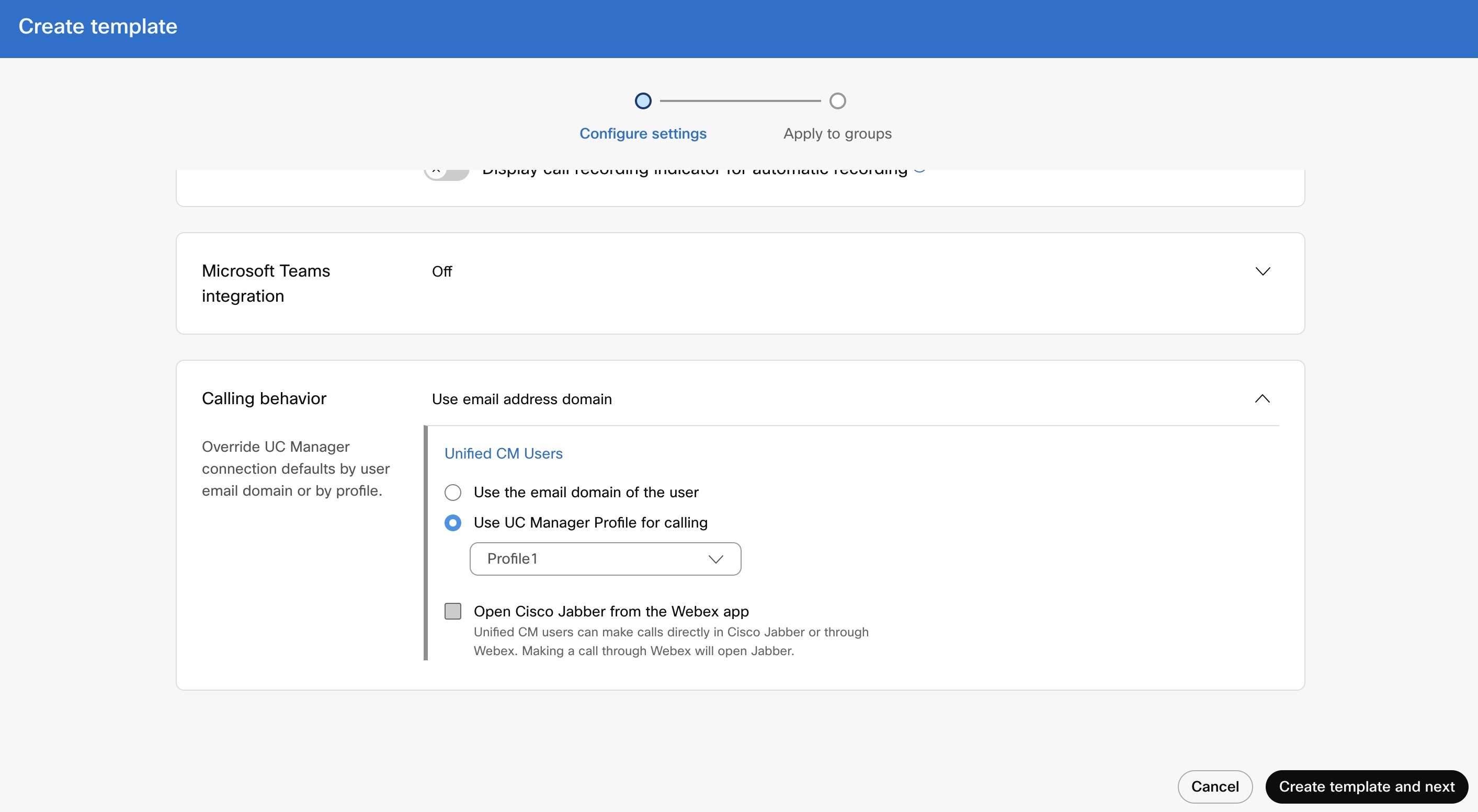- Ana Sayfa
- /
- Makale

Arama davranışlarını ayarlama
 Bu makalede
Bu makalede Geri Bildirim?
Geri Bildirim?Kullanıcılar Webex Uygulamasından arama yaptığında hangi arama uygulamasının açılacağını kontrol edin.
Unified CM, Webex Calling yetkisine sahip kullanıcıları olan ve Cisco'nun ücretli arama hizmetlerine sahip olmayan kullanıcıları olan kuruluşlar için karma mod dağıtımı da dahil olmak üzere istemcinin arama ayarlarını yapılandırabilirsiniz. Kullanıcının arama lisansına bağlı olarak arama davranış seçenekleri ayarlanabilir.
-
Unified CM lisanslı kullanıcılar için, doğrudan Cisco Jabber'dan veya Webex Uygulaması aracılığıyla arama yapmayı ayarlayabilir ve kullanıcılara uygulanacak etki alanını (kuruluş etki alanı veya UC Manager profili) seçebilirsiniz. Ayarları kuruluş düzeyinde, grup düzeyinde ve kullanıcı düzeyinde yapılandırabilirsiniz.
-
Cisco'nun ücretli arama servislerinden yararlanamayan kullanıcılar için, aramaları başlatmak üzere üçüncü taraf uygulamaları ayarlayabilirsiniz. Varsayılan olarak, Webex Uygulaması üzerinden yapılan tüm aramalar "Webex'te Ara" seçeneğini kullanır. Ayarları kuruluş düzeyinde yapılandırabilirsiniz.
-
Webex Calling lisanslı kullanıcılar için, arama yapmak için varsayılan arama uygulaması Webex Uygulamasıdır. Bu nedenle, belirli bir çağrı davranışı yapılandırmasına gerek yoktur.
Kuruluş düzeyinde çağrı davranışı ayarlarını etkinleştirin
| 1 | |||||||||||||||||
| 2 |
| ||||||||||||||||
| 3 |
Arama Davranışı bölümüne gidin ve Cisco'dan Ücretli Arama Hizmetleri olmayan Unified CM Kullanıcıları ve Kullanıcılar için arama davranışı seçeneklerini ayarlayın. Unified CM Kullanıcıları İçin:
Birleşik CM kullanıcı verilerinin toplu olarak dışa aktarılması
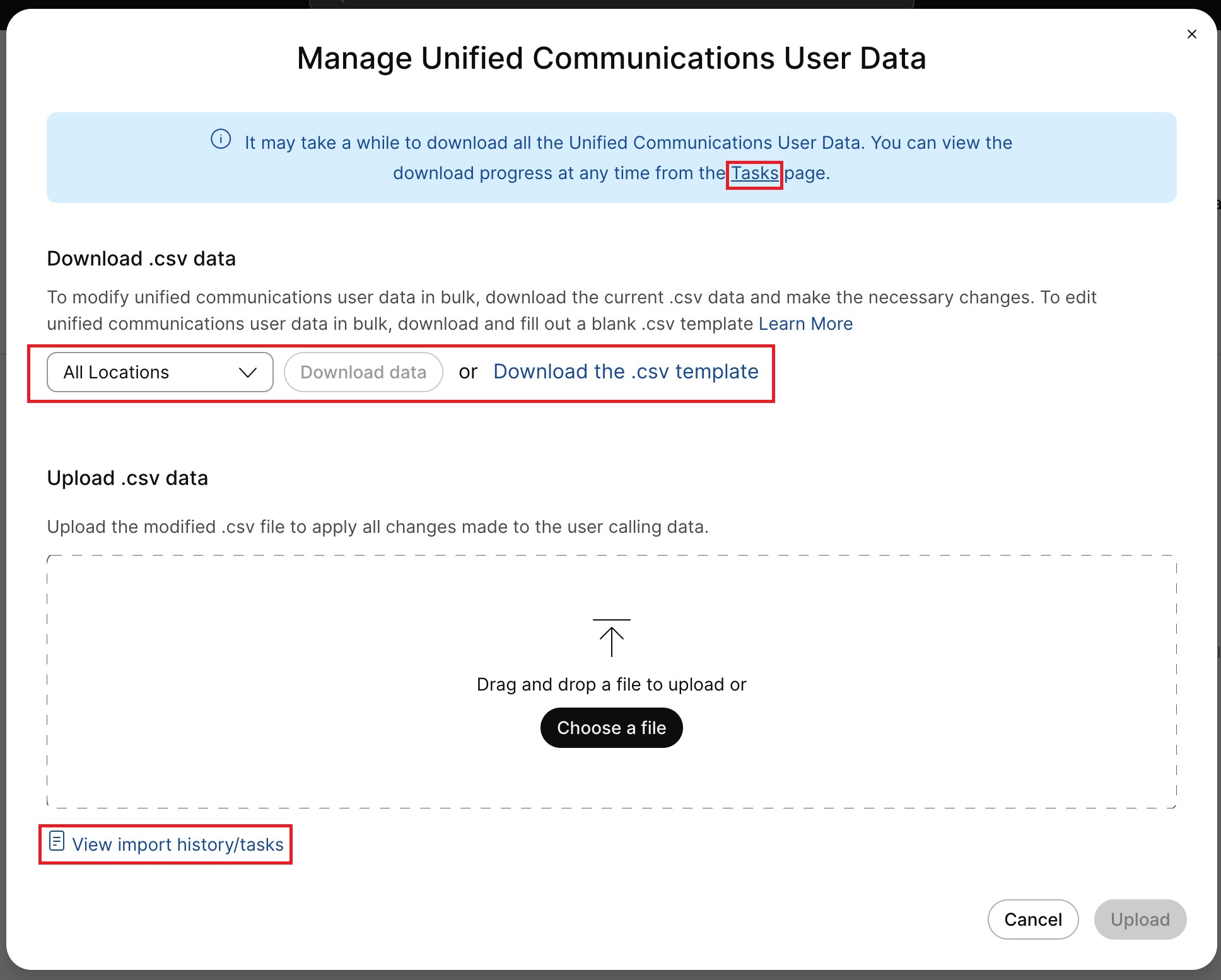 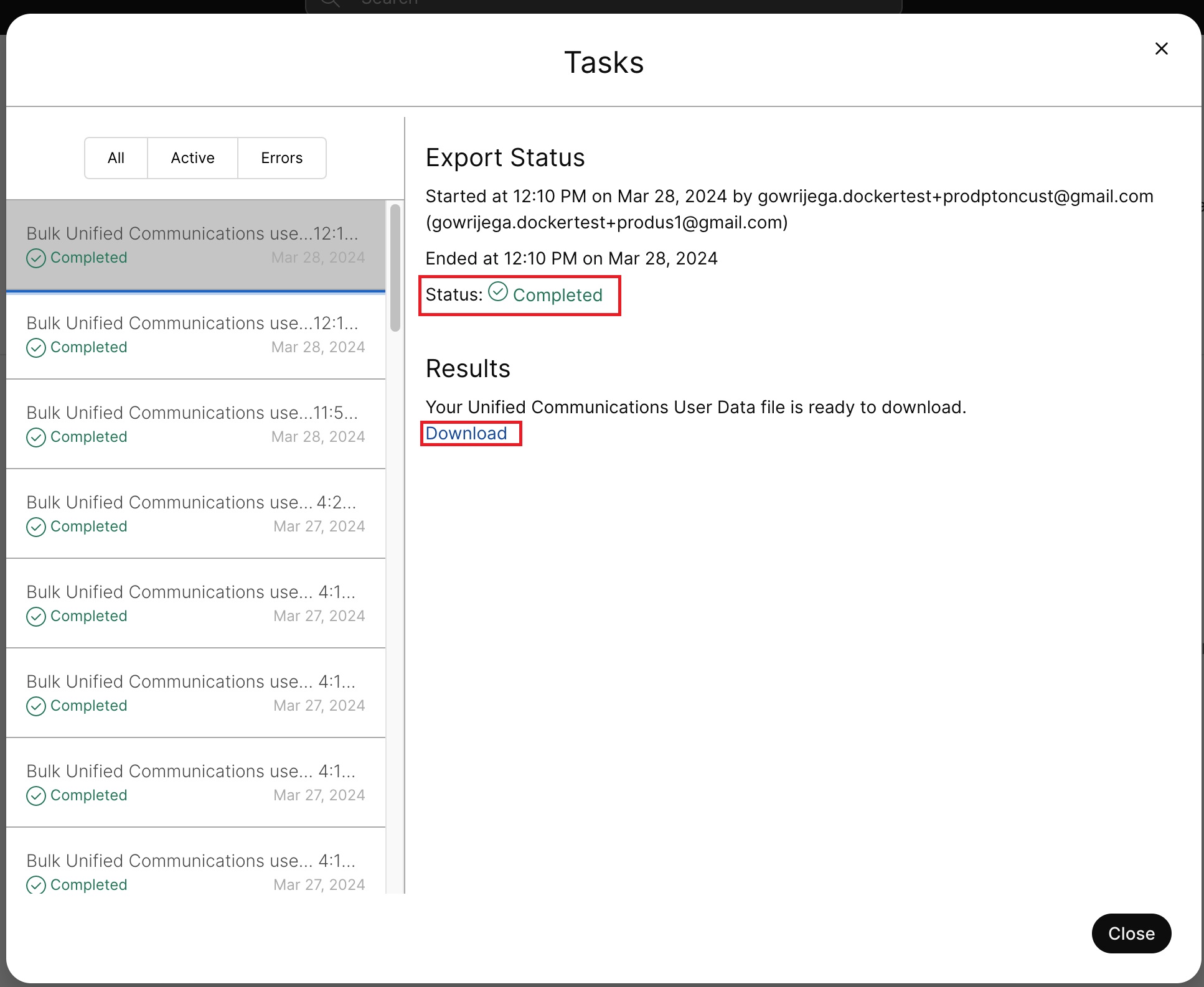
Etkili Çağrı Davranışı, Çağrı Davranışı Kaynağıve UCM Profili Kaynağı alanlarında yapılan değişiklikler CSV yüklenirken dikkate alınmaz. Bu alanlar yalnızca bilgilendirme amaçlıdır. Yeni bir değiştirilmiş CSV yüklemek, değişiklikleri yalnızca kullanıcı düzeyine uygular (kuruluş ve grup düzeylerini geçersiz kılar) ancak USE_ORG_SETTINGShariç. Cisco'dan Ücretli Arama Hizmetleri Olmayan Kullanıcılar İçin:
|
Grup düzeyinde arama davranışı ayarlarını etkinleştirin
Bir Çağrı şablonu aracılığıyla bir kullanıcı grubu için Birleşik İletişim Yöneticisi çağrı davranışı organizasyon ayarlarını etkinleştirebilirsiniz. Bir şablon oluşturup kullanıcı grubuna atayabilirsiniz. Şablondaki yapılandırma gruptaki tüm kullanıcılar için geçerlidir.
Bir şablon oluşturmak için:
Başlamadan önce
Kullanıcının Unified Communications Manager lisansına sahip olduğundan emin olun. Daha fazla bilgi için bkz.: Bireysel kullanıcılar için hizmet lisanslarını düzenleyin.
| 1 | |
| 2 |
Hizmetler altında sekmesi. Kullanıcı şablonları ve Webex Uygulaması şablonlarının listesi ilgili sekmeler altında görüntülenir.
|
| 3 |
. |
| 4 |
Genel bölümüne Şablon adı ve açıklamayazın. |
| 5 |
Çağrı davranışı bölümüne gidin ve aşağıdaki ayarları güncelleyin.
|
| 6 |
Şablon oluştur'a ve ardından tıklayın. |
| 7 |
Arama kutusunda bu şablon için bir grup ara ve seçin. |
| 8 |
Bitti’ye tıklayın. Şablonu silmek için şablona tıklayın ve [ Eylemler açılır listesinden Sil [ öğesini seçin. Şablonu sil sayfasında, şablonu silmenin kalıcı olduğunu bildiren onay kutusunu işaretleyin ve ardından Silöğesine tıklayın. Şablonu değiştirmek için şablona tıklayın, geçişleri değiştirin ve Kaydetöğesine tıklayın. |
Mevcut bir şablonu bir kullanıcı grubuna uygulamak için:
Çağrı şablonları uygularken dikkate gereken birkaç işaretçi:
-
Bir kullanıcı bir kuruluşa eklendiğinde, kullanıcı kuruluş düzeyindeki ayarları devralır.
-
Kullanıcı bir kullanıcı grubuna eklenirse Çağrı şablonu ayarları geçerlidir.
-
Bir kullanıcı birden fazla kullanıcı grubuna aitse, en yüksek rütbeye (Rütbe 1) sahip şablon en yüksek önceliğe sahip olur ve bu şablon ayarları geçerli olur.
-
Kullanıcının bireysel kullanıcı ayarları varsa, bu ayarlar kullanıcı grubu veya kuruluş düzeyindeki ayarlara göre önceliklidir.
Şablonlarınızı yönetme hakkında daha fazla bilgi için Ayar şablonlarını yapılandırma bölümüne bakın.
Mevcut şablonu Grup bölümünden veya Çağrı bölümünden uygulayabilirsiniz.
Şablonu Grup bölümünden uygulamak için bkz: Ayar şablonunu yapılandırın.
Çağrı bölümünden başvuruda bulunmak için aşağıdaki adımları izleyin:
| 1 | |
| 2 |
Sol gezinme çubuğunda Hizmetler 'e gidin ve ardından . |
| 3 |
Mevcut bir şablonun yanındaki … simgesini tıklayın ve ardından Şablonu uygulaöğesini tıklayın. |
| 4 |
Şablonu uygulamak istediğiniz grup adını yazın ve ardından grubu seçin. |
| 5 |
Bitti’ye tıklayın. |
Kullanıcı düzeyinde çağrı davranışı organizasyon ayarlarını geçersiz kılın
Başlamadan önce
Kullanıcının Unified CM lisansına sahip olduğundan emin olun. Daha fazla bilgi için bkz.: Bireysel kullanıcılar için hizmet lisanslarını düzenleyin.
| 1 | |
| 2 |
ve değiştirmek istediğiniz kullanıcıyı seçin. |
| 3 |
. |
| 4 |
Kuruluşun varsayılan ayarlarını kullanıcı ayarlarıyla geçersiz kılmak için Kuruluş düzeyi ayarlarını kullan seçeneğini kapatın. Kuruluşun varsayılan ayarlarına geri dönmek için Kuruluş düzeyindeki ayarları kullanöğesini açın. Bu geçiş yalnızca kullanıcı herhangi bir grubun parçası olmadığında ve kuruluş düzeyi ayarlarını geçersiz kılmadığında görünür. 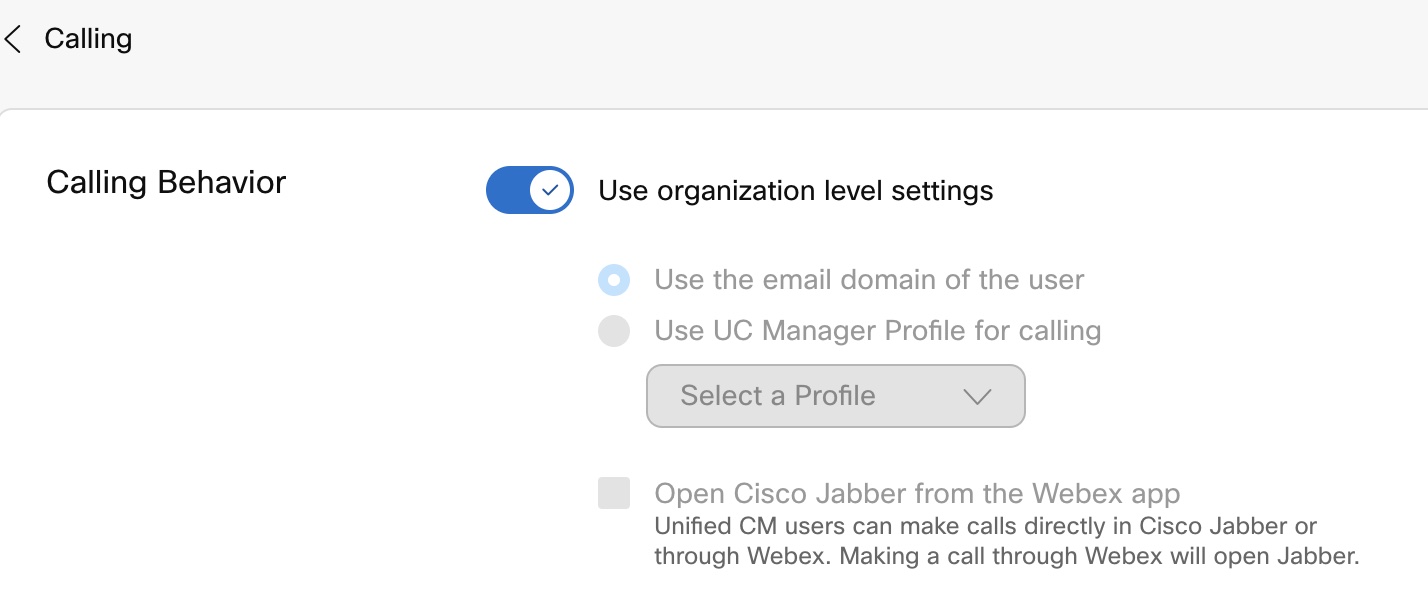 |
| 5 |
Aşağıdaki çağrı davranışı ayarlarını güncelleyin:
|
| 6 |
Kaydet 'e tıklayın ve Evet' i onaylayın. |
Kullanıcı düzeyinde çağrı davranışı grup düzeyi ayarlarını geçersiz kılın
Başlamadan önce
-
Kullanıcının Unified CM lisansına sahip olduğundan emin olun. Daha fazla bilgi için bkz.: Bireysel kullanıcılar için hizmet lisanslarını düzenleyin.
-
Kullanıcının, çağrı şablonunun atandığı bir kullanıcı grubunun parçası olduğundan emin olun.
| 1 | |
| 2 |
ve değiştirmek istediğiniz kullanıcıyı seçin. |
| 3 |
. |
| 4 |
Aşağıdaki çağrı davranışı ayarlarını güncelleyin:
|
| 5 |
Kaydet ' e tıklayın ve Geçersiz kılma ayarınıonaylayın. |
Sıfırla seçeneği yalnızca kullanıcı için devralınan ayarları geçersiz kıldığınızda kullanılabilir.
